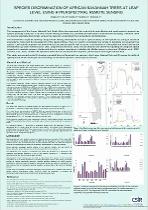 ResearchSpace
ResearchSpace
Species discrimination of African savannah trees at leaf level using hyperspectral remote sensing
JavaScript is disabled for your browser. Some features of this site may not work without it.
- ResearchSpace
- →
- Research Publications/Outputs
- →
- Conference Publications
- →
- View Item
| dc.contributor.author |
Majeke, B

|
|
| dc.contributor.author |
Cho, Moses A

|
|
| dc.contributor.author |
Debba, Pravesh

|
|
| dc.contributor.author |
Mathieu, Renaud SA

|
|
| dc.contributor.author |
Ramoelo, Abel

|
|
| dc.date.accessioned | 2009-04-07T11:07:05Z | |
| dc.date.available | 2009-04-07T11:07:05Z | |
| dc.date.issued | 2009-03 | |
| dc.identifier.citation | Majeke, B., Cho, M.A., Debba, P., Mathieu, R. and Ramoelo, A. 2008. Species discrimination of African savannah trees at leaf level using hyperspectral remote sensing. 6th EARSeL SIG IS Workshop, Tel Aviv University, Tel Aviv, Israel; March 16-19, 2009, pp 1 | en |
| dc.identifier.uri | http://hdl.handle.net/10204/3291 | |
| dc.description | 6th EARSeL SIG IS Workshop, Tel Aviv University, Tel Aviv, Israel; March 16-19, 2009 | en |
| dc.description.abstract | The management of the Kruger National Park, South Africa has expressed the need to find cost-effective and rapid means to assess species diversity in the park. Remote sensing is viewed as a cost-effective alternative to intensive field sampling. This study was carried out to assess the utility of hyperspectral remote sensing in discriminating the dominant species in the southern part of the park. The spectral reflectances of seven common tree species (Combretum apiculatum, Combretum hereroense, Combretum zeyheri, Gymnosporia buxifolia, Gymnosporia senegalenses, Lonchocarpus capassa, Terminalia sericea) were measured using the ASD spectrometer (Analytical Spectral Radiometer (ASD) (350-2500 nm)). Ten (10) leaf reflectances were collected for each tree species. Four different similarity measures, namely, spectral correlation measure (SCM), spectral angle mapper (SAM), Spectral information divergence (SID) and a combination of SAM and SID (with either sin or tan) were used to measure the similarities amongst species. Two statistical approaches were used to determine the performance of the various similarity measures, namely, relative spectral discriminatory probability (RSDPB) and relative spectral discriminatory power (RSDPW). These similarity and discriminability measures were applied to the whole spectrum, visible range, near infrared (NIR) range and short wave infra red (SWIR) range to determine which method show great similarities/ dissimilarities amongst species and in which range | en |
| dc.language.iso | en | en |
| dc.subject | Hyperspectral | en |
| dc.subject | Remote sensing | en |
| dc.subject | Kruger National Park | en |
| dc.subject | African savannah | en |
| dc.subject | Species discrimination | en |
| dc.subject | Hyperspectral remote sensing | en |
| dc.subject | 6th EARSeL SIG IS Workshop | en |
| dc.title | Species discrimination of African savannah trees at leaf level using hyperspectral remote sensing | en |
| dc.type | Conference Presentation | en |
| dc.identifier.apacitation | Majeke, B., Cho, M. A., Debba, P., Mathieu, R. S., & Ramoelo, A. (2009). Species discrimination of African savannah trees at leaf level using hyperspectral remote sensing. http://hdl.handle.net/10204/3291 | en_ZA |
| dc.identifier.chicagocitation | Majeke, B, Moses A Cho, Pravesh Debba, Renaud SA Mathieu, and Abel Ramoelo. "Species discrimination of African savannah trees at leaf level using hyperspectral remote sensing." (2009): http://hdl.handle.net/10204/3291 | en_ZA |
| dc.identifier.vancouvercitation | Majeke B, Cho MA, Debba P, Mathieu RS, Ramoelo A, Species discrimination of African savannah trees at leaf level using hyperspectral remote sensing; 2009. http://hdl.handle.net/10204/3291 . | en_ZA |
| dc.identifier.ris | TY - Conference Presentation AU - Majeke, B AU - Cho, Moses A AU - Debba, Pravesh AU - Mathieu, Renaud SA AU - Ramoelo, Abel AB - The management of the Kruger National Park, South Africa has expressed the need to find cost-effective and rapid means to assess species diversity in the park. Remote sensing is viewed as a cost-effective alternative to intensive field sampling. This study was carried out to assess the utility of hyperspectral remote sensing in discriminating the dominant species in the southern part of the park. The spectral reflectances of seven common tree species (Combretum apiculatum, Combretum hereroense, Combretum zeyheri, Gymnosporia buxifolia, Gymnosporia senegalenses, Lonchocarpus capassa, Terminalia sericea) were measured using the ASD spectrometer (Analytical Spectral Radiometer (ASD) (350-2500 nm)). Ten (10) leaf reflectances were collected for each tree species. Four different similarity measures, namely, spectral correlation measure (SCM), spectral angle mapper (SAM), Spectral information divergence (SID) and a combination of SAM and SID (with either sin or tan) were used to measure the similarities amongst species. Two statistical approaches were used to determine the performance of the various similarity measures, namely, relative spectral discriminatory probability (RSDPB) and relative spectral discriminatory power (RSDPW). These similarity and discriminability measures were applied to the whole spectrum, visible range, near infrared (NIR) range and short wave infra red (SWIR) range to determine which method show great similarities/ dissimilarities amongst species and in which range DA - 2009-03 DB - ResearchSpace DP - CSIR KW - Hyperspectral KW - Remote sensing KW - Kruger National Park KW - African savannah KW - Species discrimination KW - Hyperspectral remote sensing KW - 6th EARSeL SIG IS Workshop LK - https://researchspace.csir.co.za PY - 2009 T1 - Species discrimination of African savannah trees at leaf level using hyperspectral remote sensing TI - Species discrimination of African savannah trees at leaf level using hyperspectral remote sensing UR - http://hdl.handle.net/10204/3291 ER - | en_ZA |





